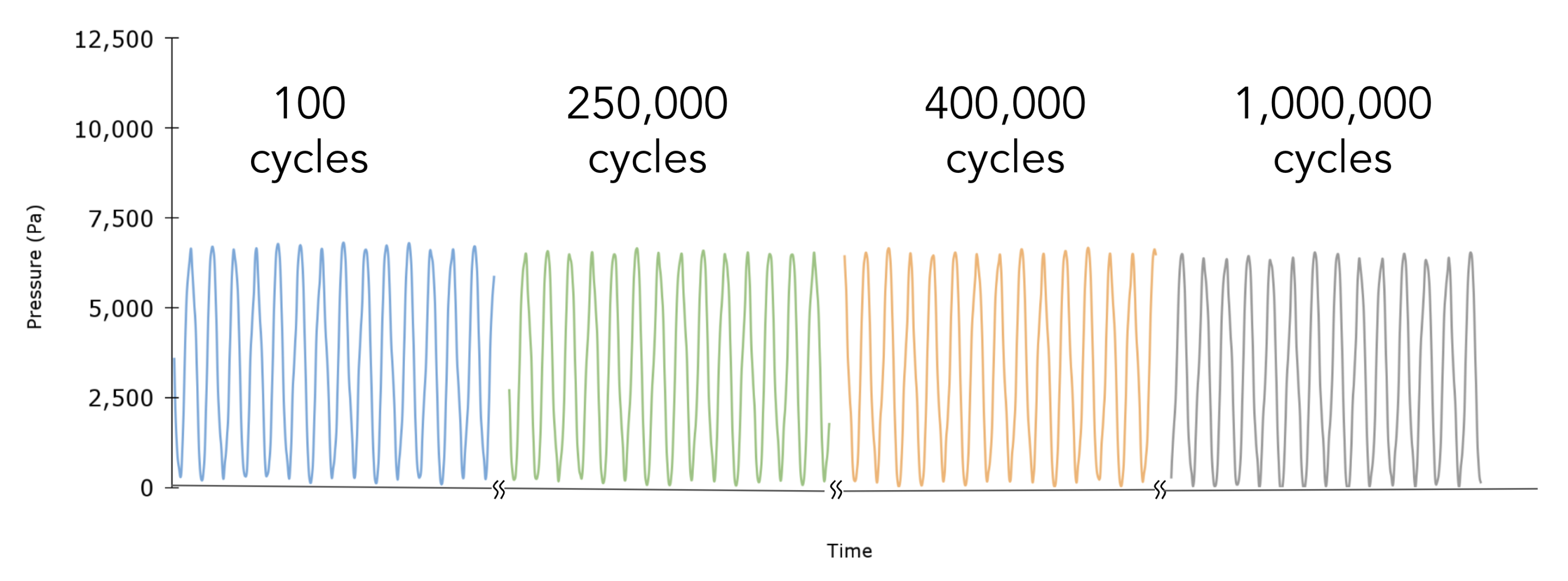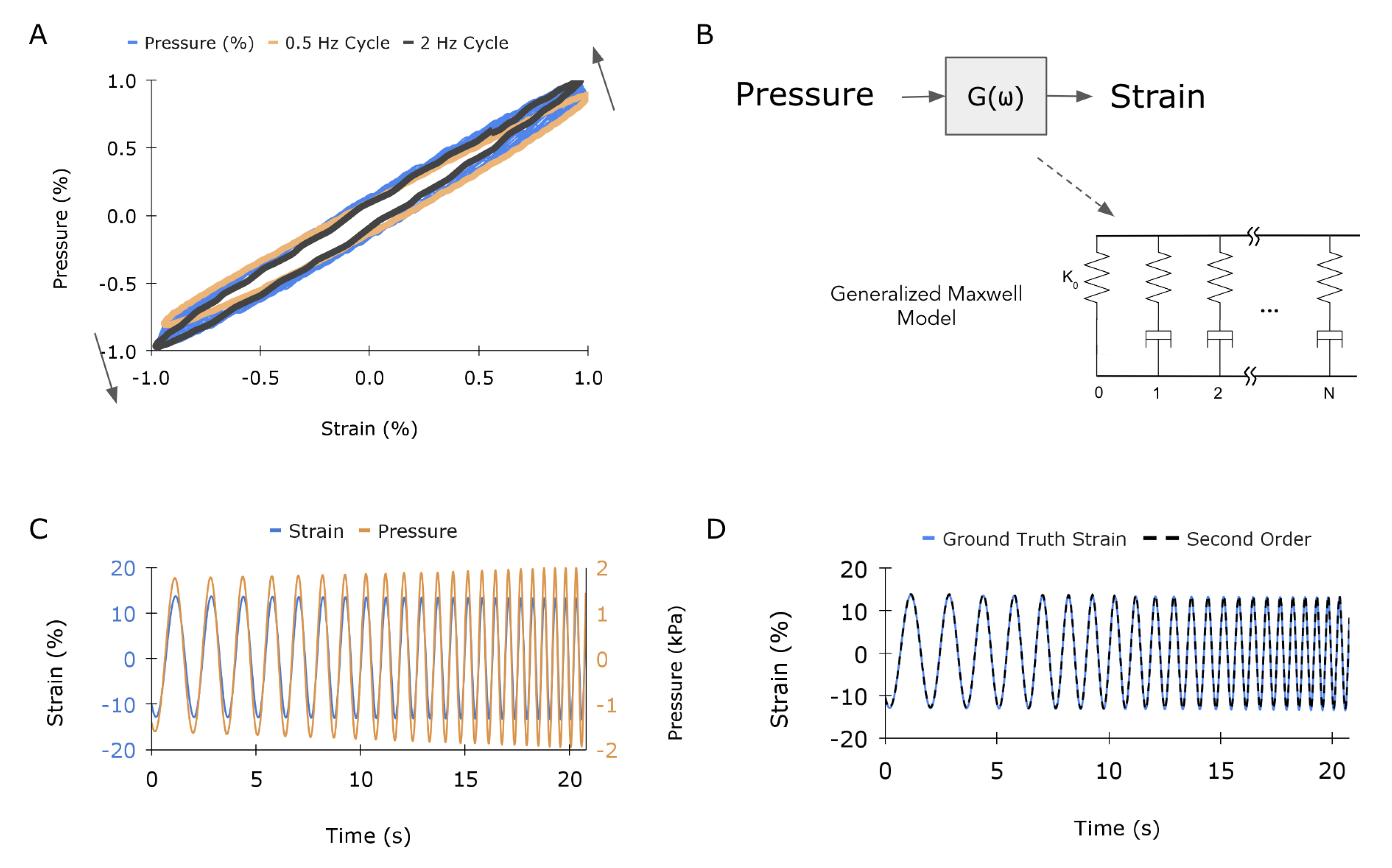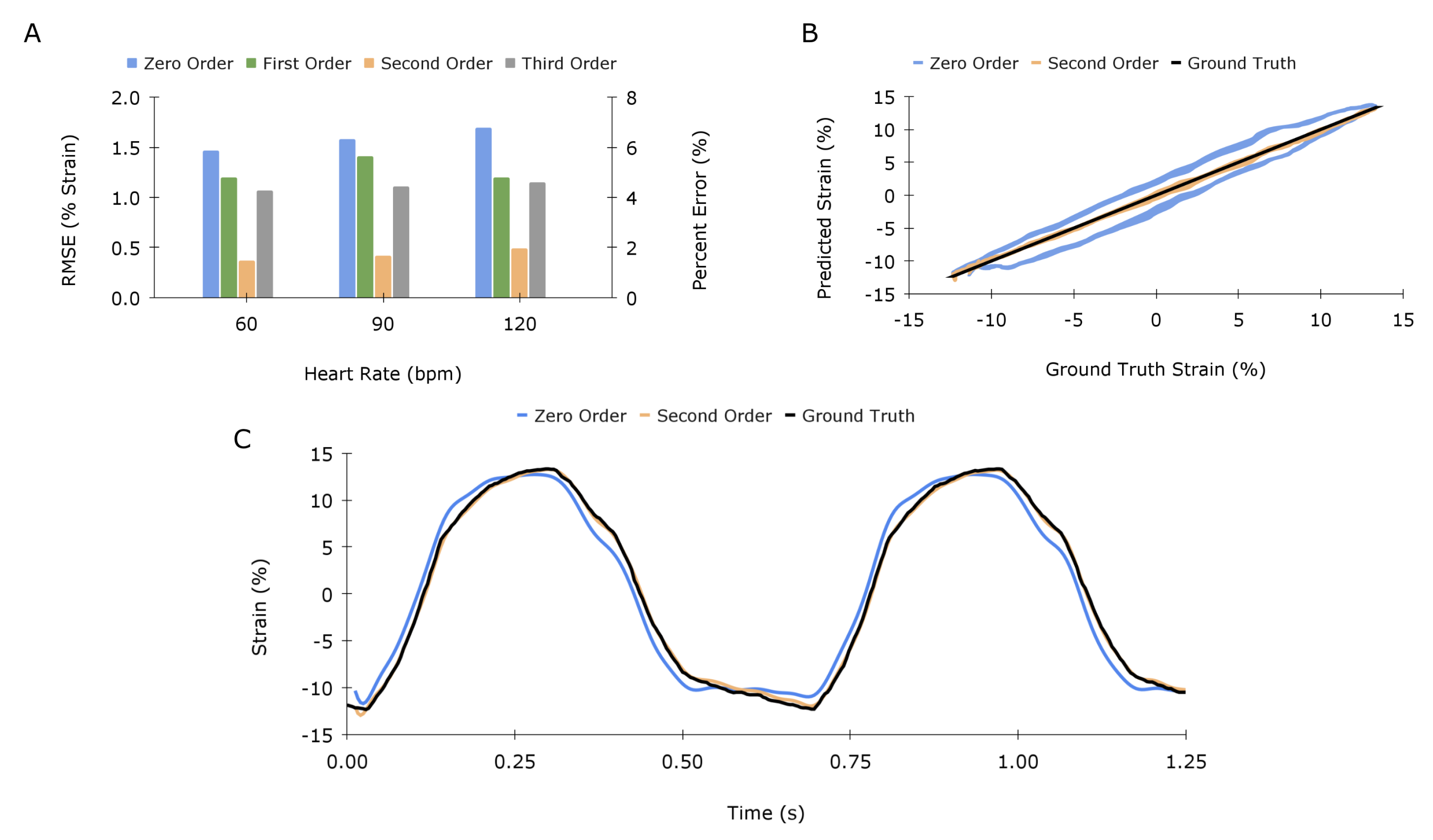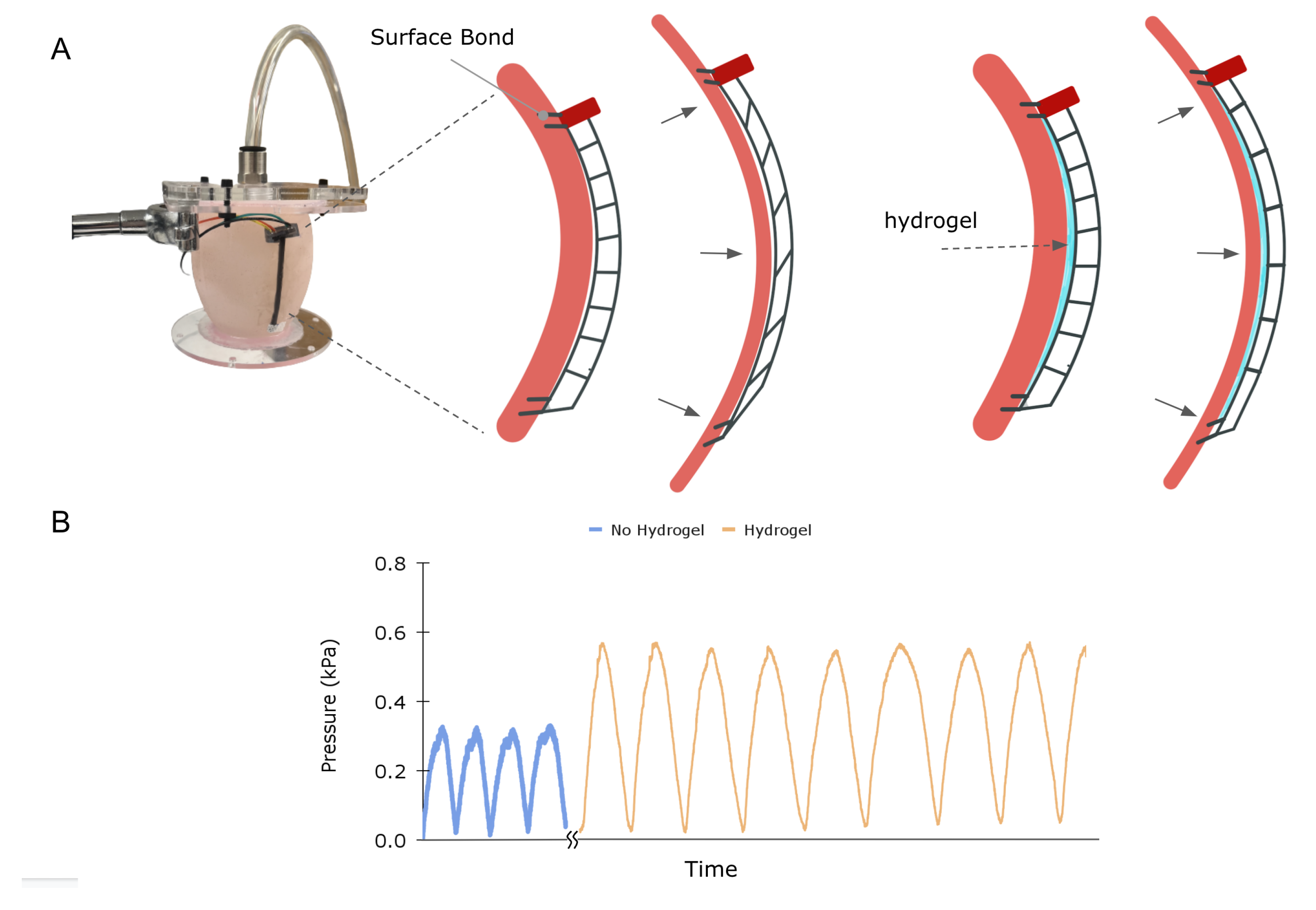Decoupling Transmission and Transduction for Improved Durability of Highly Stretchable, Soft Strain Sensing: Applications in Human Health Monitoring
Abstract
1. Introduction
2. Sensor Concept and Application
2.1. Sensing Principle
2.2. Application
- Soft: comparable to the stiffness of native heart tissue (50 kPa [24]).
- Durable: consistent signal over at least a million cycles (corresponding to about 11 days at 60 beats per minute).
- Selectively Sensitive: insensitive to non-uniaxial strain signals that might occur, such as bending from the heart’s torsion or pressure from external organs.
- Conformable: consistent signal on a dynamic and compliant curved surface.
- Extensibile: achievable strains of at least 20% with a corresponding stable and predictable signal [25].
- Dynamic: consistent and accurate signal at various heart rates and under dynamic load profiles that contain various frequency components.
- Biocompatible: made of non-toxic materials that can be implanted with minimal inflammatory response from the tissue.
3. Sensor Design and Fabrication
3.1. Application-Specific Design Selections
3.2. Sensor Fabrication
4. Sensor Characterization
4.1. Quasi-Static Characterization
4.2. Decoupling Undesirable Signals
4.3. Durability
4.4. Dynamic Characterization
5. Application-Specific Testing
5.1. Strain Sensing of a Realistic Heartbeat
5.2. Dynamic Curvature
6. Discussion
Author Contributions
Funding
Data Availability Statement
Acknowledgments
Conflicts of Interest
Abbreviations
| MDPI | Multidisciplinary Digital Publishing Institute |
| DOAJ | Directory of open access journals |
| TLA | Three letter acronym |
| LD | Linear dichroism |
References
- Liu, H.; Li, Q.; Zhang, S.; Yin, R.; Liu, X.; He, Y.; Dai, K.; Shan, C.; Guo, J.; Liu, C.; et al. Electrically conductive polymer composites for smart flexible strain sensors: A critical review. J. Mater. Chem. C 2018, 6, 12121–12141. [Google Scholar] [CrossRef]
- Tang, L.; Wu, S.; Qu, J.; Gong, L.; Tang, J. A review of conductive hydrogel used in flexible strain sensor. Materials 2020, 13, 3947. [Google Scholar] [PubMed]
- Amjadi, M.; Kyung, K.U.; Park, I.; Sitti, M. Stretchable, skin-mountable, and wearable strain sensors and their potential applications: A review. Adv. Funct. Mater. 2016, 26, 1678–1698. [Google Scholar] [CrossRef]
- Park, J.; You, I.; Shin, S.; Jeong, U. Material approaches to stretchable strain sensors. ChemPhysChem 2015, 16, 1155–1163. [Google Scholar] [CrossRef] [PubMed]
- Zhang, H.; Lowe, A.; Kalra, A.; Yu, Y. A Flexible Strain Sensor Based on Embedded Ionic Liquid. Sensors 2021, 21, 5760. [Google Scholar] [CrossRef]
- Zhang, H.; Niu, W.; Zhang, S. Extremely stretchable, stable, and durable strain sensors based on double-network organogels. ACS Appl. Mater. Interfaces 2018, 10, 32640–32648. [Google Scholar] [CrossRef]
- Liu, Z.; Qi, D.; Leow, W.R.; Yu, J.; Xiloyannnis, M.; Cappello, L.; Liu, Y.; Zhu, B.; Jiang, Y.; Chen, G.; et al. 3D-structured stretchable strain sensors for out-of-plane force detection. Adv. Mater. 2018, 30, 1707285. [Google Scholar] [CrossRef]
- Yang, J.C.; Lee, S.; Ma, B.S.; Kim, J.; Song, M.; Kim, S.Y.; Kim, D.W.; Kim, T.S.; Park, S. Geometrically engineered rigid island array for stretchable electronics capable of withstanding various deformation modes. Sci. Adv. 2022, 8, eabn3863. [Google Scholar]
- Boutry, C.M.; Kaizawa, Y.; Schroeder, B.C.; Chortos, A.; Legrand, A.; Wang, Z.; Chang, J.; Fox, P.; Bao, Z. A stretchable and biodegradable strain and pressure sensor for orthopaedic application. Nat. Electron. 2018, 1, 314–321. [Google Scholar] [CrossRef]
- Yoshida, A.; Wang, Y.F.; Sekine, T.; Takeda, Y.; Kumaki, D.; Tokito, S. Printed Low-Hysteresis Stretchable Strain Sensor Based on a Self-Segregating Conductive Composite. ACS Appl. Eng. Mater. 2022. [Google Scholar]
- Dual, S.A.; Llerena Zambrano, B.; Sündermann, S.; Cesarovic, N.; Kron, M.; Magkoutas, K.; Hengsteler, J.; Falk, V.; Starck, C.; Meboldt, M.; et al. Continuous heart volume monitoring by fully implantable soft strain sensor. Adv. Healthc. Mater. 2020, 9, 2000855. [Google Scholar]
- Xu, L.; Gutbrod, S.R.; Bonifas, A.P.; Su, Y.; Sulkin, M.S.; Lu, N.; Chung, H.J.; Jang, K.I.; Liu, Z.; Ying, M.; et al. 3D multifunctional integumentary membranes for spatiotemporal cardiac measurements and stimulation across the entire epicardium. Nat. Commun. 2014, 5, 1–10. [Google Scholar] [CrossRef] [PubMed]
- Wang, S.; Huang, Y.; Rogers, J.A. Mechanical designs for inorganic stretchable circuits in soft electronics. IEEE Trans. Components, Packag. Manuf. Technol. 2015, 5, 1201–1218. [Google Scholar] [CrossRef] [PubMed]
- Nur, R.; Matsuhisa, N.; Jiang, Z.; Nayeem, M.O.G.; Yokota, T.; Someya, T. A highly sensitive capacitive-type strain sensor using wrinkled ultrathin gold films. Nano Lett. 2018, 18, 5610–5617. [Google Scholar] [CrossRef] [PubMed]
- Jentoft, L.P.; Tenzer, Y.; Vogt, D.; Liu, J.; Wood, R.J.; Howe, R.D. Flexible, stretchable tactile arrays from MEMS barometers. In Proceedings of the 2013 16th International Conference on Advanced Robotics (ICAR), Montevideo, Uruguay, 25–29 November 2013; pp. 1–6. [Google Scholar]
- Tenzer, Y.; Jentoft, L.P.; Howe, R.D. The feel of MEMS barometers: Inexpensive and easily customized tactile array sensors. IEEE Robot. Autom. Mag. 2014, 21, 89–95. [Google Scholar] [CrossRef]
- Gafford, J.; Ding, Y.; Harris, A.; McKenna, T.; Polygerinos, P.; Holland, D.; Moser, A.; Walsh, C. Shape deposition manufacturing of a soft, atraumatic, deployable surgical grasper. J. Med. Devices 2014, 8, 1–3. [Google Scholar]
- Khidir, M.J.; Abou, R.; Yilmaz, D.; Marsan, N.A.; Delgado, V.; Bax, J.J. Prognostic value of global longitudinal strain in heart failure patients treated with cardiac resynchronization therapy. Heart Rhythm 2018, 15, 1533–1539. [Google Scholar]
- Kalam, K.; Otahal, P.; Marwick, T.H. Prognostic implications of global LV dysfunction: A systematic review and meta-analysis of global longitudinal strain and ejection fraction. Heart 2014, 100, 1673–1680. [Google Scholar]
- Motoki, H.; Borowski, A.G.; Shrestha, K.; Hu, B.; Kusunose, K.; Troughton, R.W.; Tang, W.W.; Klein, A.L. Right ventricular global longitudinal strain provides prognostic value incremental to left ventricular ejection fraction in patients with heart failure. J. Am. Soc. Echocardiogr. 2014, 27, 726–732. [Google Scholar] [CrossRef]
- Gozdzik, A.; Letachowicz, K.; Grajek, B.B.; Plonek, T.; Obremska, M.; Jasinski, M.; Gozdzik, W. Application of strain and other echocardiographic parameters in the evaluation of early and long-term clinical outcomes after cardiac surgery revascularization. BMC Cardiovasc. Disord. 2019, 19, 189. [Google Scholar] [CrossRef]
- Lu, J.C.; Magdo, H.S.; Yu, S.; Lowery, R.; Aiyagari, R.; Zamberlan, M.; Gajarski, R.J. Usefulness of diastolic strain measurements in predicting elevated left ventricular filling pressure and risk of rejection or coronary artery vasculopathy in pediatric heart transplant recipients. Am. J. Cardiol. 2016, 117, 1533–1538. [Google Scholar] [CrossRef] [PubMed]
- Witkowski, T.G.; Thomas, J.D.; Debonnaire, P.J.; Delgado, V.; Hoke, U.; Ewe, S.H.; Versteegh, M.I.; Holman, E.R.; Schalij, M.J.; Bax, J.J.; et al. Global longitudinal strain predicts left ventricular dysfunction after mitral valve repair. Eur. Heart-J. -Cardiovasc. Imaging 2013, 14, 69–76. [Google Scholar] [CrossRef]
- Chaturvedi, R.R.; Herron, T.; Simmons, R.; Shore, D.; Kumar, P.; Sethia, B.; Chua, F.; Vassiliadis, E.; Kentish, J.C. Passive stiffness of myocardium from congenital heart disease and implications for diastole. Circulation 2010, 121, 979–988. [Google Scholar] [CrossRef] [PubMed]
- Yingchoncharoen, T.; Agarwal, S.; Popović, Z.B.; Marwick, T.H. Normal ranges of left ventricular strain: A meta-analysis. J. Am. Soc. Echocardiogry 2013, 26, 185–191. [Google Scholar]
- Bae, W.J.; Choi, J.B.; Kim, K.S.; Kim, S.J.; Cho, H.J.; Ha, U.S.; Hong, S.H.; Lee, J.Y.; Kim, S.W. AB168. Evaluation of the biocompatibility of packing materials for a catheter. Transl. Androl. Urol. 2015, 4, AB168. [Google Scholar]
- Handorf, A.M.; Zhou, Y.; Halanski, M.A.; Li, W.J. Tissue stiffness dictates development, homeostasis, and disease progression. Organogenesis 2015, 11, 1–15. [Google Scholar]
- Larson, K. Can you estimate modulus from durometer hardness for silicones. Dow Corning Corp. 2016, 1–6. [Google Scholar]
- Wang, Z.; Xiang, C.; Yao, X.; Le Floch, P.; Mendez, J.; Suo, Z. Stretchable materials of high toughness and low hysteresis. Proc. Natl. Acad. Sci. USA 2019, 116, 5967–5972. [Google Scholar] [CrossRef] [PubMed]
- Bosch Sensortec. BMP384: Digital Pressure Sensor. Rev. 1. 2020. Available online: https://media.digikey.com/pdf/Data%20Sheets/Bosch/bst-bmp384-ds003.pdf (accessed on 10 October 2022).
- Cai, G.; Wang, J.; Qian, K.; Chen, J.; Li, S.; Lee, P.S. Extremely stretchable strain sensors based on conductive self-healing dynamic cross-links hydrogels for human-motion detection. Adv. Sci. 2017, 4, 1600190. [Google Scholar] [CrossRef]
- Oliveri, A.; Maselli, M.; Lodi, M.; Storace, M.; Cianchetti, M. Model-based compensation of rate-dependent hysteresis in a piezoresistive strain sensor. IEEE Trans. Ind. Electron. 2018, 66, 8205–8213. [Google Scholar]
- Schultz, T.; Müller, R. Automatic analysis of the stress–strain response of rheological models. PAMM 2019, 19, e201900232. [Google Scholar] [CrossRef]
- Renaud, F.; Dion, J.L.; Chevallier, G.; Tawfiq, I.; Lemaire, R. A new identification method of viscoelastic behavior: Application to the generalized Maxwell model. Mech. Syst. Signal Process. 2011, 25, 991–1010. [Google Scholar]
- Jrad, H.; Dion, J.L.; Renaud, F.; Tawfiq, I.; Haddar, M. Non-linear generalized Maxwell model for dynamic characterization of viscoelastic components and parametric identification techniques. In Proceedings of the International Design Engineering Technical Conferences and Computers and Information in Engineering Conference. American Society of Mechanical Engineers, Chicago, IL, USA, 12–15 August 2012; Volume 45004, pp. 291–300. [Google Scholar]
- Smiseth, O.A.; Torp, H.; Opdahl, A.; Haugaa, K.H.; Urheim, S. Myocardial strain imaging: How useful is it in clinical decision making? Eur. Heart J. 2016, 37, 1196–1207. [Google Scholar]
- Dieudonné, J.M. The left ventricle as confocal prolate spheroids. Bull. Math. Biophys. 1969, 31, 433–439. [Google Scholar]
- Falsetti, H.L.; Mates, R.E.; Grant, C.; Greene, D.G.; Bunnell, I.L. Left ventricular wall stress calculated from one-plane cineangiography: An approach to force-velocity analysis in man. Circ. Res. 1970, 26, 71–83. [Google Scholar] [PubMed]
- Domingues, J.S.; Vale, M.d.P.; Martinez, C.B. New mathematical model for the surface area of the left ventricle by the truncated prolate spheroid. Sci. World J. 2017, 2017. [Google Scholar] [CrossRef] [PubMed]
- Roche, E.T.; Horvath, M.A.; Wamala, I.; Alazmani, A.; Song, S.E.; Whyte, W.; Machaidze, Z.; Payne, C.J.; Weaver, J.C.; Fishbein, G.; et al. Soft robotic sleeve supports heart function. Sci. Transl. Med. 2017, 9, eaaf3925. [Google Scholar] [CrossRef]








| Elements (N) | Zeros | Poles | % Error | |
|---|---|---|---|---|
| 0 | 7.35 | n/a | n/a | 5.48 |
| 1 | 6.32 | −7.26 | −5.32 | 2.25 |
| 2 | 6.17 | −11.26, −1.75 | −8.97, −1.43 | 1.76 |
| 3 | 7.14 | −7 ×, −9.33, −1.53 | −6 ×, −11.8, −1.85 | 1.80 |
Disclaimer/Publisher’s Note: The statements, opinions and data contained in all publications are solely those of the individual author(s) and contributor(s) and not of MDPI and/or the editor(s). MDPI and/or the editor(s) disclaim responsibility for any injury to people or property resulting from any ideas, methods, instructions or products referred to in the content. |
© 2023 by the authors. Licensee MDPI, Basel, Switzerland. This article is an open access article distributed under the terms and conditions of the Creative Commons Attribution (CC BY) license (https://creativecommons.org/licenses/by/4.0/).
Share and Cite
Kight, A.; Pirozzi, I.; Liang, X.; McElhinney, D.B.; Han, A.K.; Dual, S.A.; Cutkosky, M. Decoupling Transmission and Transduction for Improved Durability of Highly Stretchable, Soft Strain Sensing: Applications in Human Health Monitoring. Sensors 2023, 23, 1955. https://doi.org/10.3390/s23041955
Kight A, Pirozzi I, Liang X, McElhinney DB, Han AK, Dual SA, Cutkosky M. Decoupling Transmission and Transduction for Improved Durability of Highly Stretchable, Soft Strain Sensing: Applications in Human Health Monitoring. Sensors. 2023; 23(4):1955. https://doi.org/10.3390/s23041955
Chicago/Turabian StyleKight, Ali, Ileana Pirozzi, Xinyi Liang, Doff B. McElhinney, Amy Kyungwon Han, Seraina A. Dual, and Mark Cutkosky. 2023. "Decoupling Transmission and Transduction for Improved Durability of Highly Stretchable, Soft Strain Sensing: Applications in Human Health Monitoring" Sensors 23, no. 4: 1955. https://doi.org/10.3390/s23041955
APA StyleKight, A., Pirozzi, I., Liang, X., McElhinney, D. B., Han, A. K., Dual, S. A., & Cutkosky, M. (2023). Decoupling Transmission and Transduction for Improved Durability of Highly Stretchable, Soft Strain Sensing: Applications in Human Health Monitoring. Sensors, 23(4), 1955. https://doi.org/10.3390/s23041955






